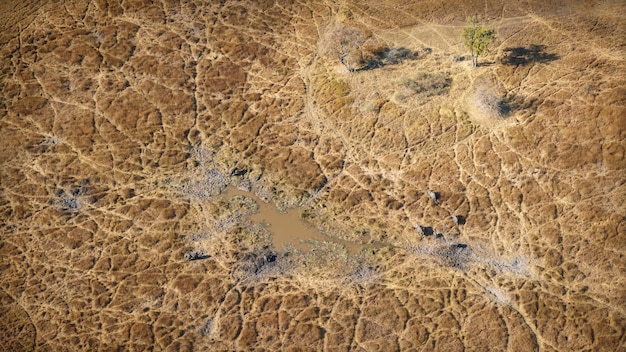Climate Change & Global Conflicts: A US National Security Threat

The Impact of Climate Change on Global Conflicts: A Growing Threat to US National Security is becoming increasingly evident, as environmental stressors exacerbate existing tensions and resource scarcity, potentially leading to increased instability and posing significant challenges to US national security interests around the globe.
The intricate relationship between climate change and global conflicts is rapidly evolving from a theoretical concern to a stark reality, directly impacting US national security interests. Rising temperatures, extreme weather events, and resource scarcity are not just environmental issues; they are catalysts for instability, migration, and violence across the globe.
The Nexus of Climate Change and Conflict
Climate change acts as a threat multiplier, intensifying existing vulnerabilities and creating new challenges for global stability. Understanding this nexus is crucial for the US to effectively address the growing threats to its national security.
Resource Scarcity
As climate change intensifies, access to essential resources like water and arable land diminishes, leading to increased competition and potential conflict among communities and nations.
Displacement and Migration
Extreme weather events and environmental degradation are forcing mass migrations, which can strain resources and create social tensions in host regions.

Climate change exacerbates existing inequalities, making marginalized communities even more vulnerable to conflict. Consider these points:
- Climate-induced displacement can overwhelm already fragile social infrastructures.
- Competition for dwindling resources heightens ethnic and tribal tensions.
- Environmental degradation can erode livelihoods, pushing individuals towards extremism.
The convergence of these factors creates a volatile mix that can destabilize entire regions and create opportunities for extremist groups to exploit grievances.
Specific Regions at Risk
Certain regions are particularly vulnerable to the climate-conflict nexus, posing direct threats to US interests and requiring strategic attention.
The Middle East and North Africa (MENA)
Water scarcity and desertification are driving instability in the MENA region, potentially exacerbating existing conflicts and creating new ones.
Sub-Saharan Africa
Climate change threatens agricultural production and food security in Sub-Saharan Africa, increasing the risk of famine, displacement, and conflict.
These regions face unique challenges, including:
- Rapid population growth exacerbating resource scarcity.
- Weak governance structures hindering effective climate adaptation.
- Geopolitical rivalries complicating regional stability efforts.
The US needs to tailor its security strategies to address the specific vulnerabilities of each region, working with local partners to build resilience and promote sustainable development.
The Impact on US Military Readiness
Climate change is not just an external threat; it also impacts the operational readiness and infrastructure of the US military.
Base Vulnerability
Rising sea levels, extreme weather events, and wildfires threaten US military bases and installations around the world.
Operational Challenges
Extreme temperatures and unpredictable weather patterns can hinder military operations and increase the risk of equipment failure.

The military needs to adapt to these challenges by:
- Investing in climate-resilient infrastructure.
- Developing new technologies and strategies for operating in extreme environments.
- Integrating climate change considerations into military planning and exercises.
By proactively addressing these challenges, the US military can maintain its readiness and effectiveness in a changing world.
Economic Implications for the United States
The economic consequences of climate-related conflicts extend far beyond the affected regions, impacting the US economy through various channels.
Trade Disruptions
Conflicts can disrupt global trade routes and supply chains, leading to increased prices for consumers and businesses in the US.
Humanitarian Aid Costs
The US often provides significant humanitarian assistance to regions affected by climate-related disasters and conflicts, straining the federal budget.
The economic costs underscore the need for proactive measures:
- Investing in climate resilience at home and abroad.
- Promoting sustainable development in vulnerable regions.
- Strengthening international cooperation to address climate change.
These investments can mitigate the economic risks of climate-related conflicts and create new opportunities for US businesses and innovation.
Policy Recommendations for the US Government
Addressing the climate-conflict nexus requires a comprehensive policy approach that integrates climate action with national security strategies.
Climate Diplomacy
The US should lead international efforts to reduce greenhouse gas emissions and promote climate adaptation, working with allies and partners to address this global challenge.
Security Assistance
The US should provide security assistance to vulnerable regions to help them build resilience to climate-related threats and manage conflicts peacefully.
These recommendations highlight the importance of a joined-up approach:
- Integrating climate considerations into all aspects of foreign policy and national security planning.
- Investing in research and analysis to better understand the climate-conflict nexus.
- Strengthening partnerships with international organizations and civil society groups.
By implementing these policies, the US can protect its national security interests while promoting a more sustainable and peaceful world.
The Role of International Cooperation
Climate change is a global challenge that requires international cooperation. The US cannot address the climate-conflict nexus alone; it needs to work with other nations to achieve meaningful progress.
Sharing Best Practices
Nations can share best practices for climate adaptation, conflict resolution, and sustainable development, helping each other build resilience to climate-related threats.
Collective Action
International agreements and initiatives can provide a framework for collective action, ensuring that all nations contribute to reducing greenhouse gas emissions and promoting climate adaptation.
Effective international cooperation depends on:
- Building trust and mutual understanding among nations.
- Establishing clear goals and targets for climate action.
- Providing financial and technical assistance to developing countries.
By working together, nations can overcome the challenges posed by climate change and build a more secure and sustainable future for all.
| Key Point | Brief Description |
|---|---|
| 🌍 Resource Scarcity | Diminishing resources like water and land lead to conflicts. |
| 🏠 Displacement | Extreme weather forces mass migrations, straining resources. |
| 🛡️ US Military Impact | Bases are vulnerable; operations face climate-related challenges. |
| 🤝 International Cooperation | Global cooperation is essential for climate action and conflict resolution. |
Frequently Asked Questions
▼
Climate change acts as a threat multiplier by exacerbating existing tensions over resources, increasing displacement, and undermining livelihoods. These factors can lead to instability and conflict, particularly in vulnerable regions.
▼
The Middle East and North Africa (MENA) and Sub-Saharan Africa are particularly vulnerable due to water scarcity, desertification, and threats to agricultural production. These issues can fuel local and regional conflicts.
▼
Climate change threatens US military bases through rising sea levels and extreme weather, and it can hinder military operations due to unpredictable conditions. The military must adapt to maintain its readiness.
▼
Climate-related conflicts can disrupt trade, increase humanitarian aid costs, and strain the US economy. Investing in climate resilience and sustainable development can mitigate these risks.
▼
The US government can lead international climate action, provide security assistance to vulnerable regions, and integrate climate considerations into its foreign policy and national security planning.
Conclusion
In conclusion, the impact of climate change on global conflicts: a growing threat to US national security is undeniable. Addressing this complex issue requires a multifaceted approach that combines climate action, security assistance, and international cooperation. By proactively tackling the climate-conflict nexus, the US can protect its interests, promote global stability, and contribute to a more sustainable and peaceful future.





